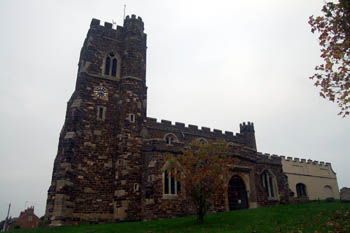Early Education in Flitton

The church from the south October 2010
Volume 81 published by Bedfordshire Historical Records Society (2002) is a series of episcopal visitations undertaken in the first twenty years of the 18th century, edited by former County Archivist Patricia Bell. At each visitation a list of questions was sent out in advance, one of which enquired about the provision of schools in each parish. In 1706 the response for Flitton and Silsoe was: "There is no School, Lecture, Almeshouse [sic] or Hospital endow'd within this parish". By 1709, however there was a charity school at Flitton for nine boys or girls. This school seems to have closed by 1717 when only a school for fourteen children is recorded which was probably in Silsoe since the 1709 return recorded a school for fourteen in that village. The entry for 1720 for Flitton and Silsoe says: "We have no publick [sic] of charity School".
On 13th November 1763 the Earl of Hardwicke's steward wrote to his master: "Your Lordship will pardon my troubling you with this minutia which proceeds from my unwillingness to take any steps in this affair without your Lordship's approbation. We have a poor widow here at Flitton who undertakes to teach several children. I propose to put five to her and five to Widow Harrison [in Silsoe] for the £5 and to lay out the remaining five shillings in books for them". [CRT100/27/3 page 45]. In 1779 he wrote that he hoped to be able to place four children at a school in Flitton (implying that there was not one in the village at the time) as well as four in Silsoe and stated that there had been schools in both places in the time of the Duke of Kent [CRT100/27/4 p. 199], as can be seen from the episcopal visitation of 1709.
In 1818 a Select Committee was established to enquire into educational provision for the poor. This was no doubt prompted, in part, by the recent foundation of two societies promoting education and specifically the building of schools. The Society for Promoting the Lancasterian System for the Education of the Poor was established in 1808 promoting schools run along the lines pioneered by Joseph Lancaster, who had himself copied those of Dr. Andrew Bell, in which older children taught their younger fellows. The Society was renamed the British and Foreign School Society in 1814. It was supported by a number of prominent nonconformists, Lancaster himself was a Quaker, and sought to teach a non-sectarian curriculum. In answer to this perceived nonconformist takeover of local education the National Society was formed in 1811 to encourage the teaching of poor children along Anglican lines, including the catechism. The Select Committee sent a questionnaire to all parishes in the country asking for: particulars relating to endowments for the education of children; other educational institutions; observations of parish needs etc. At that date the parish of Flitton included Silsoe. The return noted that as far as Flitton was concerned £170 had been left by one of the Earls of Kent and two –fifths of the interest was applied towards supporting the Sunday school containing 42 boys and 58 girls. In those days a Sunday School was just that, a school which met on a Sunday, usually in the church or nonconformist chapel or other similar building, teaching more than the religious topics with which they are associated today.
In the country generally the number of schools built continued to grow over the next fifteen years so that by 1833 the government agreed to supplement the work of the two societies, and local benefactors, by making £20,000 per annum available in grants to help build schools. It also prompted another questionnaire to be sent to each parish in England asking for details of local educational provision. The return for Flitton lists a Sunday school supported by subscription for 35 boys and 49 girls. This Sunday school was evidently held in the church because in 1839 it was noted: "A Hair Trunk which holds the Children's School Books to be placed out of sight" [ABV28].
The next national enquiry was in 1846/7 when the Church of England made an enquiry as to all its church schools. This was against the background of a new Whig government which championed secular education and the increasing importance of nonconformists, particularly Wesleyan Methodist, and Roman Catholics in providing schools. The return for Flitton listed a Sunday school for 34 boys and 42 girls.